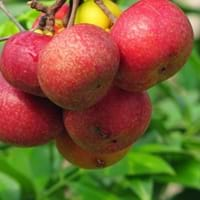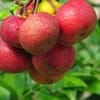Life Span
Perennial
Perennial
Origin
India
Eastern Europe
Types
Pednem Keri, Kasarpal, Parashte
Not Available
Habitat
Foot Hills, Tropical regions
Terrestrial
USDA Hardiness Zone
9-11
4-9
AHS Heat Zone
Not Available
9-1
Sunset Zone
Not Available
1a, 1b, 2a, 2b, 3a, 3b, 4, 5, 6, 7, 8, 9, 10, 11, 12, 13, 14, 15, 16, 17, 18, 19, 20, 21, 22, 23, 24
Habit
Spreading
Clump-Forming
Flower Color
Dark Pink
Yellow, Lavender, Blue Violet
Flower Color Modifier
Bicolor
Bicolor
Fruit Color
Burgundy
Not Available
Leaf Color in Spring
Light Green, Gray Green, Copper
Green, Sea Green
Leaf Color in Summer
Green, Gray Green
Green, Sea Green
Leaf Color in Fall
Green, Gray Green
Green, Sea Green
Leaf Color in Winter
Olive, Gray Green
Light Green
Leaf Shape
Oblong-lanceolate
Lanceolate
Plant Season
Spring, Summer, Fall, Winter
Spring, Summer
Sunlight
Full Sun, Partial Sun, Partial shade
Full Sun, Partial Sun
Type of Soil
Clay, Loam, Sand
Loam, Sand
The pH of Soil
Acidic, Neutral, Alkaline
Neutral
Soil Drainage
Well drained
Well drained
Bloom Time
Early Spring
Spring, Late Spring, Early Summer
Tolerances
Drought, Salt
Drought
Where to Plant?
Ground
Ground
How to Plant?
Grafting, Seedlings
By dividing rhizomes, tubers, Seedlings
Plant Maintenance
Medium
Medium
Watering Requirements
Do Not over Water, Needs more water during establishment
Average Water Needs, Do Not over Water
In Summer
Lots of watering
Lots of watering
In Spring
Moderate
Moderate
In Winter
Average Water
Average Water
Soil pH
Acidic, Neutral, Alkaline
Neutral
Soil Type
Loam, Sand
Loam, Sand
Soil Drainage Capacity
Well drained
Well drained
Sun Exposure
Full Sun, Partial shade
Full Sun, Partial Sun
Pruning
Remove damaged leaves, Remove dead branches, Remove dead leaves
Remove damaged leaves, Remove dead branches, Remove dead leaves
Fertilizers
All-Purpose Liquid Fertilizer
All-Purpose Liquid Fertilizer
Pests and Diseases
Leafminers, Red blotch, Root mealy bugs
Red blotch
Plant Tolerance
Drought
Drought
Flower Petal Number
Single
Single
Foliage Texture
Coarse
Coarse
Foliage Sheen
Matte
Matte
Attracts
Bees, Birds, Butterflies, Not Available
Hummingbirds
Allergy
Not Available
Skin irritation
Aesthetic Uses
Not Available
Showy Purposes
Beauty Benefits
For treating wrinkles, Good for skin and hair, Hair Conditioner, Makes Hair Silkier, Promotes Healthy Hair
Not Available
Environmental Uses
Air purification
Air purification
Medicinal Uses
Anthelmintic, Antitumor, Astringent, Cardiotonic, Dysentry, Indigestion
Not Available
Part of Plant Used
Fruits
Not Available
Other Uses
Edible syrup, Used for its medicinal properties, Used to make juice
Used as Ornamental plant
Used As Indoor Plant
No
No
Used As Outdoor Plant
Yes
Yes
Garden Design
Fruit, Fruit / Fruit Tree
Alpine, Edging, Mixed Border, Rock Garden, Wall
Botanical Name
Garcinia indica
IRIS pumila
Common Name
Kokum
Dwarf Iris
In Hindi
Kokum
Dwarf Iris
In German
Kokum
Zwergiris
In French
Kokum
Dwarf Iris
In Spanish
Kokum
Enano Iris
In Greek
Kokum
νάνος Ίρις
In Portuguese
Kokum
Dwarf Iris
In Polish
Kokum
Dwarf Iris
In Latin
Kokum
Iris Dwarf
Phylum
Magnoliophyta
Magnoliophyta
Class
Magnoliopsida
Liliopsida
Family
Zamiaceae
Iridaceae
Clade
Angiosperms, Eudicots, Rosids
Angiosperms, Monocots
Subfamily
Clusioideae
Iridoideae
Number of Species
Not Available
Not Available
Importance of Kokum and Dwarf Iris
Want to have the most appropriate plant for your garden? You might want to know the importance of Kokum and Dwarf Iris. Basically, these two plants vary in many aspects. Compare Kokum and Dwarf Iris as they differ in many characteristics such as their life, care, benefits, facts, etc. Every gardener must at least have the slightest clue about the plants he wants to plant in his garden. Compare their benefits, which differ in many ways like facts and uses. The medicinal use of Kokum is Anthelmintic, Antitumor, Astringent, Cardiotonic, Dysentry and Indigestion whereas of Dwarf Iris is Not Available. Kokum has beauty benefits as follows: For treating wrinkles, Good for skin and hair, Hair Conditioner, Makes Hair Silkier and Promotes Healthy Hair while Dwarf Iris has beauty benefits as follows: For treating wrinkles, Good for skin and hair, Hair Conditioner, Makes Hair Silkier and Promotes Healthy Hair.
Compare Facts of Kokum vs Dwarf Iris
How to choose the best garden plant for your garden depending upon its facts? Here garden plant comparison will help you to solve this query. Compare the facts of Kokum vs Dwarf Iris and know which one to choose. As garden plants have benefits and other uses, allergy is also a major drawback of plants for some people. Allergic reactions of Kokum are Not Available whereas of Dwarf Iris have Skin irritation respectively. Having a fruit bearing plant in your garden can be a plus point of your garden. Kokum has showy fruits and Dwarf Iris has no showy fruits. Also Kokum is flowering and Dwarf Iris is flowering. You can compare Kokum and Dwarf Iris facts and facts of other plants too.





